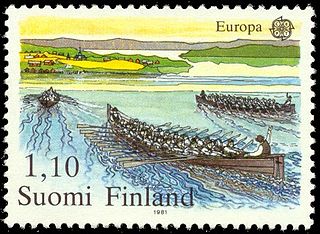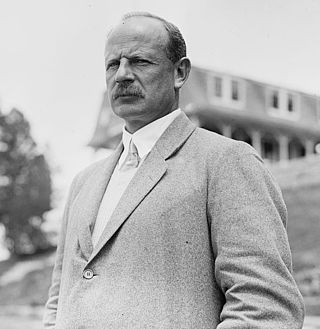
Rowing, oftentimes called crew in the United States, is the sport of racing boats using oars. It differs from paddling sports in that rowing oars are attached to the boat using rowlocks, while paddles are not connected to the boat. Rowing is divided into two disciplines: sculling and sweep rowing. In sculling, each rower holds two oars, one in each hand, while in sweep rowing each rower holds one oar with both hands. There are several boat classes in which athletes may compete, ranging from single sculls, occupied by one person, to shells with eight rowers and a coxswain, called eights. There are a wide variety of course types and formats of racing, but most elite and championship level racing is conducted on calm water courses 2 kilometres (1.2 mi) long with several lanes marked using buoys.

Leander Club, founded in 1818, is one of the oldest rowing clubs in the world, and the oldest non-academic club. It is based in Remenham in Berkshire, England and adjoins Henley-on-Thames. Only three other surviving clubs were founded prior to Leander: Brasenose College Boat Club and Jesus College Boat Club and Westminster School Boat Club, founded in 1813.

British Rowing, formerly the Amateur Rowing Association (ARA), is the national governing body for the sport of rowing. It is responsible for the training and selection of individual rowers and crews representing Great Britain and England, and for participation in and the development of rowing in England. Scottish Rowing and Welsh Rowing oversee governance in their respective countries, organise their own teams for the Home International Regatta and input to the GB team organisation.

The Thames Rowing Club (TRC) is a rowing club based on the tidal Thames as it flows through the western suburbs of London. The TRC clubhouse stands on Putney Embankment. The club was founded in 1860.

The history of rowing as a sport has prevailed it as one of the oldest traditions in the world. What began as a method of transport and warfare eventually became a sport with a wide following, and a part of the cultural identity of the English speaking world. Rowing in its modern form developed in England in the 1700s.
Julius Beresford (Wiszniewski) (18 July 1868 – 29 September 1959), also known as Berry or The Old Berry, was a British rower and coach. Beresford competed at the 1912 Summer Olympics in Stockholm, Sweden.
Arthur Stanley Garton was a British rower who competed in the 1912 Summer Olympics.
Leslie Graham Wormald was an English rower who competed in the 1912 Summer Olympics representing Great Britain.

Ewart Douglas Horsfall MC was a British rower who competed in the 1912 Summer Olympics and in the 1920 Summer Olympics.

Cecil Leventhorpe McVilly MC, was an Australian representative rower and WWI military officer. He was a three-time Australian champion sculler and the first sculler to represent Australia at an Olympic games, rowing at the 1912 Summer Olympics, In 1913 he won the Diamond Challenge Sculls at the Henley Royal Regatta. As an AIF Lieutenant in the Tasmanian raised 40th Battalion, he saw action on the Western Front and later in Mesopotamia and the Defence of Baku. He was awarded the Military Cross for his leadership at the 2nd Battle of Messines.

Raymond Broadley Etherington-Smith was an English doctor and rower who competed for Great Britain in the 1908 Summer Olympics.
Michael John Hart MBE is a British former rower who competed in the 1972 Summer Olympics and in the 1976 Summer Olympics.

Guy Nickalls was a British rower who competed in the 1908 Summer Olympics as a member of the British eight that won gold, won 22 events at Henley Royal Regatta and won the Wingfield Sculls three times.
Guy Richard Pooley is an English rower who has competed for Great Britain in the Olympic Games, raced four times in the University Boat race and won major sculling events at Henley Royal Regatta and Head races.

Simon Fraser Jr. was an Australian sportsman who was an Olympic rower and played high-level Australian rules football. In football he played with Essendon and University in the Victorian Football League (VFL). As a rower he represented Australia at the 1912 Stockholm Olympics and was a member of the first Australian eight to win the Grand Challenge Cup at the Henley Royal Regatta. In ice hockey he played for the Beavers Ice Hockey Club, one of the four founding teams in the newly founded Victorian Amateur Ice Hockey Association.
John Haviland Dashwood Goldie was an English rower, and barrister. He was the Cambridge University Boat Club President between 1870 and 1872, won the Colquhoun Sculls in 1870 and captained Leander Club between 1873 and 1876. He was known by his middle name of "Dashwood" by his family and close friends.

Alfred Cecil Dicker was an English clergyman and rower who won the Diamond Challenge Sculls at Henley Royal Regatta three times and the Wingfield Sculls twice.
James Cardwell Gardner, also known by his nickname Jumps Gardner, was an English medical doctor and amateur rower who won the Diamond Challenge Sculls at Henley Royal Regatta and the Wingfield Sculls and rowed for Cambridge in the Boat Race in 1888, 1889 and 1890.

Christopher Guy Vere Davidge, of Little Houghton House, OBE DL was a British rower who competed in the Summer Olympics three times in 1952, 1956 and 1960 and won the Silver Goblets at Henley Royal Regatta three times.
Polly Swann is a British rower and a member of the Great Britain Rowing Team. She is a former World and European champion in the women's coxless pairs, having won the 2013 World Rowing Championships at Chungju in Korea, and the 2014 European Rowing Championships at Belgrade, Serbia with her partner Helen Glover. At the 2016 Summer Olympics she won a silver medal in the women's eight.












